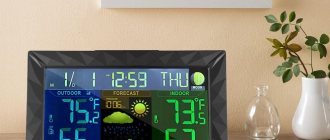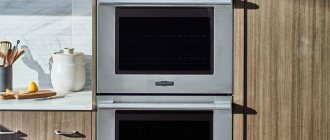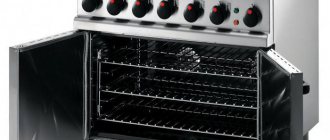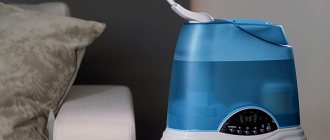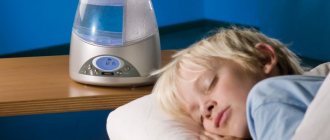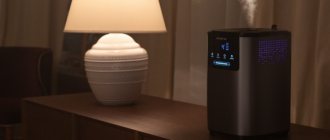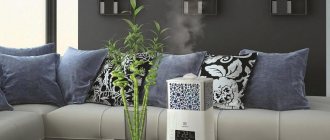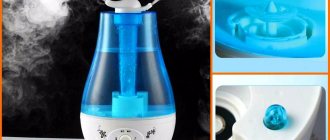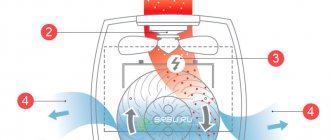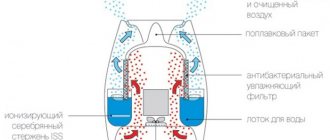Why are humidifiers needed?
An air humidifier is a unique device. It is necessary to create an optimal indoor microclimate.
Other important functions of this device include:
- maintaining the required level of humidity in the room;
- elimination of static electricity charges (they can arise in dry air);
- cleaning the air from dust and microparticles of dirt, etc.
Air humidifiers prevent the development of various diseases of the upper and lower respiratory tract. They have a beneficial effect on skin, hair and nails, preventing the aging process. These devices can also be used to prevent nosebleeds in adults and children.
General rules for operating air humidifiers
Before connecting the humidifier to the network, you need to check the tightness of its housing and cord. If the housing is cracked or the cord is damaged, the product cannot be connected to the outlet. If the device fails, you need to contact a service center.
It (like any other equipment) is guaranteed. But the warranty will be void if you repair the humidifier yourself.
Features of activating the humidifier
To turn on the humidifier, you must first connect it to the power supply by inserting the plug into the outlet. Then (depending on the type of device) you should press the on/off button on the unit body or activate the device using the remote control.
When the humidifier is turned on, the green indicator on its body lights up, and when turned off, the red icon lights up
All additional functions of the humidifier are indicated on the display after switching on. To activate them, press the desired button on the LCD screen.
Features of using different types of humidifiers
The humidifier should be placed on a dry and level surface. The machine must be in a stable position, otherwise it may tip over during operation. Tilt of the device may interfere with its normal operation.
You should not install the humidifier at a slight angle, even if it is well secured.
Before turning on a traditional type of humidifier, you need to place a filter in the water tray, attach the lower part of the device and secure the housing.
Then you need to fill the tank with distilled water and close the lid. After this, you should place the container on the lower part, turn on the device and select the most suitable mode using the switch on the body of the product.
If you need to turn on the steam humidifier, you should first fill it with water, keeping an eye on the liquid level indicator in the device. Then you need to turn on the device and select the operating mode.
During operation, the green indicator on the device body will light up. When all the water has evaporated from the tank, the indicator will turn red and the unit itself will automatically turn off.
When using an ultrasonic humidifier, one day before turning it on, you need to place the demineralization cartridge in a container with clean water. The next day, you need to fill the tank with water, close it with a lid and insert it into the housing. After this, you should install the part with the sprayer and turn on the unit.
Ultrasonic humidifiers are among the most modern and functional technology, and therefore they are often used in offices and other commercial premises.
If everything is done correctly, the green indicator on the device will light up. Then you need to select the appropriate mode and adjust the desired humidity level. When this parameter is reached, the humidifier will turn off on its own.
Safety precautions when working with a humidifier
Before turning on the humidifier, you should read its operating instructions. It provides general recommendations for using the device.
However, when using any type of humidifier, it is prohibited to:
- add liquid to the reservoir of the switched on device;
- use dirty water;
- rearrange the device plugged into the outlet;
- add flavoring agents directly to the water (there is a special compartment for this);
- pour water into the humidifier through the hole intended for the release of water vapor;
- block this hole, etc..
The operating time of the device depends on its design features. Steam humidifiers can achieve the desired level of humidification in just a couple of hours. But traditional models usually work slower and sometimes saturate the air with moisture for 10-12 hours.
Information on how long and at what mode the humidifier should operate in order to achieve the optimal level of humidity in the room can be found in the instructions.
Water is heavier than air, and moistened air currents automatically go down, and therefore it is better to install the device on a small elevation from the floor (for example, on a stool, coffee table, wall shelf or bedside table). Devices with large tanks (8-9 l) can be placed on a cabinet or high shelves.
When choosing the optimal location for installing a humidifier in a living room or office, you need to unplug it from the socket.
A small humidifier should be at a minimum distance of 50 cm from the floor. If you place the device on the floor, a small puddle will soon appear around it.
Due to the nature of its operation, this device should not be placed next to:
- electrical appliances;
- walls (otherwise unsightly stains may appear on the wallpaper);
- upholstered furniture;
- books and clothes;
- central heating radiators (on the contrary, they dry out the air and can negate the benefits of using a humidifier).
The distance from these items to the humidifier should be about 30 cm so that moisture does not settle on them. Fine particles of water (after all, steam is one of the physical states of water) that get on technical devices can disrupt the operation of any equipment.
There should be enough free space around a household humidifier with any operating principle for normal air circulation
If there is an aquarium in the room, then you should not place a humidifier next to it. This is simply impractical, because water also evaporates from the aquarium, humidifying the air. Those. a double humidification effect is created, which can also negatively affect the indoor microclimate. Due to too much humidity in the apartment, pulmonary diseases worsen, and mold appears on the walls.
If there are children or pets in the house, the device should be placed out of their reach. In this case, it would be appropriate to install even a small air humidifier on a cabinet or high shelf.
Sometimes something like a plastic grill or fence is designed for the humidifier to prevent small children, dogs and cats from reaching it.
If there are no small children or pets in the apartment, then the humidifier can be placed in the middle of the room at some distance from the furniture. But the device should not interfere with free movement.
It is also important to remember that the humidifier is powered by electricity, so it must be installed near an outlet. If possible, you should avoid using surge protectors, extension cords and adapters, since these are additional connections and unnecessary contacts.
Tips for choosing
Due to the fact that retail chains and various Internet sites are oversaturated with such household appliances, it would be useful for the average person to know how to choose the right ultrasonic humidifier for their home. Several factors need to be taken into account:
- area of the humidified room;
- functionality and noiselessness of the device;
- product quality and manufacturer;
- When choosing a humidifier for children, consider the issue of safe use.
Everything is clear about the serviced area; information about it is contained in the documentation attached to any product. Otherwise, there is the issue of noiselessness, because checking the device in a store and at home are 2 different things. When using an ultrasonic humidifier in the bedroom at night, it turns out that it gurgles and rustles, preventing you from resting peacefully. Therefore, while still in the store, you should listen well to the device while checking.
Some functions of the humidifier may also be unnecessary, for example, a bright display backlight or a standard hygrometer. The first prevents the child from sleeping, and the second can simply lie while being near a source of moisture. So don't waste money on something you don't need or even harmful. Regarding manufacturers, there are several brands that top the rating of ultrasonic humidifiers. These include Western European brands Boneco, Ballu and Electrolux.
Simpler and cheaper products are offered by Polaris, Vitek and Neoclima, but they do not shine with quality. According to reviews, problems with Chinese ultrasonic humidifiers begin at the stage of studying the instructions. It is extremely meager and often does not even explain where and how to pour water, which leads to the failure of the new device due to the filling of the electronic unit. One of the user reviews about the operation of a cheap humidifier is shown in the video:
Read also: When can you drink alcohol after ceftriaxone?
Advice. When choosing, remember that the best ultrasonic humidifier is the one that will ensure the health and safety of your loved ones, especially children. If there is a person living in the apartment who suffers from any serious illness, be sure to consult with your doctor before purchasing a humidifier.
What kind of water can be used in a humidifier?
Not only the duration of operation of the device, but also the nature of the device’s effect on the human body depends on the quality of the water poured into the humidifier. If you use ordinary tap water in the unit, the salts and chlorides dissolved in it will enter the humidified air, and then end up in the respiratory tract of all people in the room.
Children suffer especially badly from bad water in a humidifier, because they breathe at a higher speed and intensity than adults, and therefore many harmful substances will enter their lungs and bronchi.
Also, using dirty tap water has a detrimental effect on the functioning of the device parts. Scale forms on them, and the elements quickly become unusable.
To prevent this from happening, you need to use only clean water (bottled, distilled, demineralized, spring or artesian).
In addition, you can pour boiled and filtered water into the device, but this is often not recommended.
Some chemical compounds (including salts) in tap water are not filtered and do not precipitate after boiling, and therefore can subsequently have a detrimental effect on the health of household members and on the operation of the humidifier itself.
Standing tap water will also not bring much effect. Typically, water is left to settle for 7-8 hours, assuming that in the first 2 hours, chlorine and hydrogen sulfide compounds evaporate from the liquid, and then heavy metal particles are removed from it. But in fact, it will still not be purified.
The best rule to follow is to only fill the humidifier reservoir with water that you can give to your child or drink yourself.
Today, many people are afraid to drink even filtered and boiled tap water, so why put it in humidifiers? It makes more sense to spend money on normal, clean water now than to look for money for medicine later.
Pure artesian water is even sold in vending machines on the streets, and it is inexpensive. Clean, moist air will automatically increase pulmonary immunity, and saving “on matches” (on elementary water!) will not lead to anything good.
If the humidifier does not use all the water from the reservoir in a day, it still needs to be changed and the container cleaned. The fact is that a warm and important environment is perfect for the growth of bacteria.
After turning off the device, you should empty all the water and wash the tank if the device will not be used for the next few hours
The humidifier should not stand with water. When servicing the humidifier and draining the water, it should be unplugged. Otherwise, you may get an electric shock.
General rules of use
Everything is simple here: I poured water into the reservoir, adjusted the steam supply and turned it on. The device is placed on a flat surface and away from the ubiquitous hands of children and curious pets. So as not to fall. It is better to refuse extension cords, surge protectors and adapters. The fewer “links” there are in the connection to the power grid, the less risk of causing a fire.
Before turning on, the gadget must be checked for leaks. If it leaks, water from the tank can get onto the wire, and then, look, trouble will follow. If there are cracks on the case and the wire is even slightly damaged, connecting a humidifier to it is akin to suicide.
Interesting article: Mobile air conditioner: what it is, how it works and 4 reasons to buy
Safety precautions
Any humidifier works directly with water. And safety rules are based on the “neighborhood” of the conductor liquid with electrical appliances. It is prohibited here:
- Add water while the device is turned on (if this is not provided in the instructions)
There is a high possibility of a short circuit.
- Cover the nozzle where the steam comes from
Otherwise, moisture will settle on the contacts.
- Take process water
The device will quickly become clogged and unusable.
- Use liquid with additives
If you want aromatherapy, you should choose devices with this function; there is a separate container for aromatic oils.
- Carry a running device
Water may get into the connection, causing a short circuit.
It is advisable that the device stands at a height of at least 0.5-1 m from the floor. Humid air is heavier than dry air and settles faster. This can lead to condensation forming under the device.
It is important to maintain a distance of 0.3-0.5 m from the gadget to a nearby object. For example, for wooden furniture and non-moisture resistant walls - constantly flowing steam destroys the integrity of the coating. On the equipment, the settled steam will “flood” the contacts, notebooks, documents - they will become damp.
What kind of water should I put in my humidifier?
It is better to take distilled, bottled or filtered water. The fact is that the impurities that were in the liquid initially remain after evaporation. If there was a lot of iron in the water, everyone in the room will breathe it.
Poor quality water clogs filters and nozzles and causes accelerated scale formation. And this leads to damage to the device. So it will be easier to spend time filtering water, but will extend the life of the device and improve your health.
Note: How to choose the right dehumidifier: which one is better - 5 characteristics
Can you add essential oils to a humidifier?
Only in those cases where it is marked on the devices “with an aroma diffuser”. Their design provides a separate reservoir for aromatic oils. If you add flavorings to the main container, the final result is unpredictable.
Those oils that say “for aromatherapy” on the packaging are suitable. You should not save, as using low-quality oil can clog the device and negatively affect household members.
It is not recommended to constantly use aromatic oils - this can also negatively affect the well-being of people in the room.
Using supplements wisely involves three steps.
- Add 3-5 drops of aroma oil to the reservoir.
- Turn on the diffuser for an hour.
- Observe the well-being of household members.
If everything went well, you can increase the aromatherapy time each time. If the smell leads to headaches and other discomfort, it is better to abandon it.
Is it possible to sleep with a humidifier on?
Yes, if the device has an auto-shut-off function, like the Ardesto USH-M-BTN-4L-W. The device itself will “fall asleep” when the humidity reaches the desired value. You can also take a closer look at models with a timer - they will turn on and off “on the clock”.
Important : if the window remains slightly open at night, the purpose of the gadget’s operation is lost. More details about this in the next paragraph.
Ventilation during operation of the device
The device is designed for a certain footage; you can find it in the instructions. An open window increases this figure several times; air will constantly “leave” from the room. So, if you were wondering “should I open the window when the humidifier is running,” the answer to that is no. If you want to ventilate the room, do this before turning on the device.
Read: What is the difference between a hood and an air purifier? – 2 devices, different purposes
How to add oil to a humidifier?
Not all humidifiers can add aromatherapy oils. Under no circumstances should oil be poured directly into the spray tank. The device must support the aromatherapy function and have a special compartment into which essential oils are added and specific compounds are poured.
Such devices include:
- steam humidifiers;
- ultrasonic models;
- devices with a washing function.
Their design includes a special cassette or container. This is where the oil is poured, which is sprayed parallel to the water during operation of the humidifier. All aromatic oils poured into the spray unit must be of high quality and original.
After each procedure, you need to thoroughly rinse the device (including the cassettes for aroma oils) so that different oil liquids do not mix with each other
In this case, the volume of essential oil used depends on the area of the room. Experts recommend using no more than 5 drops for every 15 sq.m. area. If these proportions are violated, all the benefits of aromatherapy disappear, headaches, allergic reactions and attacks of nausea may occur.
As for the duration of the procedure, a humidifier with essential oils should not work like a regular wash. When using for the first time, it is better to turn off the device after half an hour or an hour of aromatherapy and look at your condition.
If dizziness or increased blood pressure occurs, the duration of the session should be reduced.
Using aroma oils in a humidifier
You can use essential oils or special solutions for aromatization only in those humidifiers in which this option is provided structurally, which is usually written about both on the packaging and in the instructions. Humidifiers with the “aromatization” option have a special tray for oils. It is strictly forbidden to add foreign substances to a container of water. The presence of aromatization does not depend on the type of humidifier. It may or may not be present in any type of device: steam, ultrasonic or “cold”.
We recommend reading: Closed heating system: typical diagrams and installation principles
It is important to use substances that are, in principle, intended for aromatherapy, of high quality. General rules for dosage are 5 drops per 15 square meters of area. An overdose can cause side effects: allergies, dizziness and migraine attacks, nausea.
Aroma oils should be used with caution in a humidifier.
You should not use fragrances every time you turn on the humidifier. The first time the aromatic oils are added for an hour, no more, and the body’s reaction is monitored. If everything is in order, the time can be increased. If problems arise, flavorings should be abandoned.
You can read more about humidifiers with aromatization function here.
How to clean a humidifier?
Any humidifier needs periodic cleaning. To descale the device, you need to take out a water container and disconnect all possible parts from the device. If there is any remaining water in the tank, it must be poured out and the tank must be thoroughly rinsed under the tap.
Before pouring detergent into the humidifier tank, the body of the device must be wiped with a soft cloth and a solution of ordinary table vinegar.
The humidifier membrane is cleaned with a special brush, which is sold complete with the device. If this brush is lost, it can be purchased separately at hardware stores.
As an alternative, a small sponge without metal threads or a fleece cloth is sometimes used. To maintain the tightness of the sealing material, you need to thoroughly dry the device between uses by removing the plug.
To clean the water tank, only soft cloths should be used. Brushes with a hard surface may cause scratches inside the tank. If too much scale has accumulated in the container, you need to take a toothbrush with soft bristles and regular table vinegar 9-15%.
To clean a humidifier with vinegar, you need:
- Open the balcony or window, as acetic acid vapors have a negative impact on health.
- Dilute half a glass of vinegar (100 ml) in 2.5 liters of clean water at room temperature.
- Pour the resulting mixture into the tank of the device.
- Plug the humidifier into the outlet and run it in fast mode for an hour (the spout of the device should be turned towards the window; it is better to leave the room during this time, closing the door tightly).
- Turn off the humidifier, disassemble and thoroughly rinse each part with water.
In addition to vinegar, you can use citric acid, soda, hydrogen peroxide and chlorine bleach to clean the device. Citric acid helps remove plaque safely.
Baking soda destroys putrid film and mold inside the device, which can appear due to high humidity. Hydrogen peroxide disinfects the humidifier reservoir. Bleach destroys pathogenic microflora in the tank and prevents its reproduction.
In addition to folk remedies, you can use commercial anti-scale preparations to clean the humidifier: Top House, Luxus Professional Technics, Unicum, BONECO A7417 Calc Off, etc.
The filters in your humidifier need to be changed every few months. The exact replacement time depends on the type of device and the quality of the water used in the device.
These filters also need to be washed periodically under running water. You cannot use aggressive chemicals to clean them: its residues cannot be completely washed off with water.
The influence of open vents on the operation of the humidifier
Any humidifier is designed to work in a room of a certain area. If the device’s passport says that it is suitable for humidifying a room of 20 sq.m., then for a room of 40 sq.m. the unit will be useless. At the same time, the device can provide a normal microclimate only if all doors and windows in the room are closed.
If a window, door or window is open in the room, the efficiency of the humidifier will decrease. This will happen for two reasons. Firstly, due to open doors and windows, the area of the room will increase. Secondly, dry air will enter the room from the street or from other rooms and reduce humidity.
The stronger the influx of dry cold air from the street, the faster the humidity level in the living room will decrease
Moreover, air humidity directly depends on its temperature. Cold air contains less moisture than warm air. For example, at +20 the air contains 17.3 g/m3 of water vapor, and at 0 degrees the maximum content is already 4.84 g/m3.
If you want to ventilate the room, then it is more rational to do this before turning on the device. But you shouldn’t leave the humidifier on all night with the window closed. Sleeping in a stuffy room, even with normal humidity, is unpleasant.
In the cold season, due to working radiators or heaters, the microclimate in the room will resemble the tropics: it will become hot and humid
A humidifier should be used not only in winter, but also in summer. The air in the apartment may become too dry due to actively operating air conditioners and climatic (weather) factors. For humidification in summer, it is best to use models with cold steam and ultrasonic devices.
The purpose of household humidifiers to create a healthy indoor microclimate
The normal air humidity in summer is 40%-60%, in winter – 35%-40%. For good health, you must always adhere to these indicators. The seeming harmlessness of too dry or too humid air is actually fraught with danger.
Low humidity leads to frequent headaches. A person may have no idea about the causes of illness if he does not know about the effect of low humidity on the body. There may be a sore throat, sore throat and difficulty swallowing. A large amount of dust, inevitable with a lack of humidity, can provoke allergies, which over time can develop into bronchitis and asthma.
When there is a lack of moisture, a person feels persistent fatigue and drowsiness, and has difficulty concentrating. The skin dries out and ages quickly. In children, dry air can cause frequent colds, as it reduces the protective functions of the mucous membranes and skin.
Low humidity is also harmful to things. Wooden furniture dries and cracks, parquet floors dry out, fabrics become electrified. In rooms with dry air, indoor plants do not breathe and dry out quickly.
A humidifier is used to combat these problems. After turning on the device, breathing in the room becomes much easier, negative symptoms recede. However, it is important to ensure that the humidity does not exceed the upper limit of the norm. Otherwise, mold and the smell of dampness will spread throughout the apartment.
We recommend reading: The length of the water heated floor circuit is the maximum and permissible for installing a heating system, how to calculate the length of the pipe, details in the photo and video
Typical problems when using a humidifier
Sometimes a number of problems arise when using air humidifiers. At the same time, you can deal with many device malfunctions yourself.
If the humidifier does not turn on, you need to check the presence of water in the tank and make sure that the device is actually connected to the mains. Often, users simply forget to plug in the humidifier and, as a result, cannot understand for a long time why it does not work.
If fine water dust does not come out of the steam outlet, then you need to thoroughly wash the device. These holes are often clogged with residual detergents. In addition to additional cleaning, you can use the regulator to set a higher humidity percentage.
Also, the absence of steam sometimes indicates that the liquid reservoir is overfilled and the supply channel is flooded. In this case, you need to drain some water and turn on the device again.
If this does not help, you need to check the condition of the membrane and the mechanism that drives it. If they are damaged, you will have to contact a service center.
If the spray is too weak, accompanied by noise, you need to check the amount of water in the container. This can happen if there is no longer liquid in the tank, but the device does not automatically turn off.
In ultrasonic models, such a malfunction may indicate contamination of the ultrasonic transducer. In this case, the converter must be removed, cleaned, dried and installed back into the humidifier.
If a whitish coating appears on the walls of the humidifier and objects in the room, you need to change the filter and start using purified distilled water
If an unpleasant odor occurs from a working humidifier, you need to check the water and membrane. A similar smell may indicate that the water in the tank has stagnated and bloomed. Then you need to drain the liquid and wash the tank. If the membrane itself is dirty, you should thoroughly rinse the emitter with clean water and dry it well.
If the display on the device does not work (does not light up), then it is better to contact a service center specialist. Such malfunctions indicate a breakdown of the electronic component of the device.
The following article will introduce you to the instructions for making a simple device for air humidification, which we advise everyone interested in improving the microclimate of the surrounding space to read.
Effective air humidifier: instructions for use
At the stage of practical operation, major and not very technical problems may arise. Many of them can be eliminated on your own. To do this, you should study the technical operating instructions for the devices. The list of “illnesses” opens with a constantly lit indicator when the engine is not running.
In such a situation, the user must check the position of the “on” handle and the presence of voltage in the network.
The list of ailments continues with a lit indicator and a running motor that does not allow moisture to escape. Checking the water level and the position of the height switch cover, which may not be closed tightly enough, will help to correct the malfunction correctly.
If the existing breakdown does not fit any of the above descriptions, you need to look further:
- The appearance of fog - even a small gap between the nozzle and the container with water will turn the water into fog. Wetting the nozzle before use will help avoid this.
- The appearance of specific noise - resonance is provoked by an insufficient amount of water and the surface on which the humidifier is installed.
- Gradual decrease in device efficiency - from time to time the humidifier may gradually reduce its speed. There may be several reasons for this. The first is the growths formed inside the gadget, and the second is poor quality water. Both problems will be eliminated by unscheduled cleaning.
- Feeling the smell of wet drops - if there is a similar “aroma” in the room, then attention should be paid to the quality of the water used. Users often forget that the water has stagnated or was not initially fresh.
Another source of the problem can be a dirty side. In both cases, unscheduled cleaning and water replacement will help get out of this situation.
Read also: Mac baren tobacco strength
Conclusions and useful video on the topic
Proper use of a humidifier increases its effectiveness. When installing the device, you should read the instructions and find the most suitable place for the device in the room.
Also, before you start using the humidifier, you should watch the video instructions to avoid common mistakes:
The humidifier can be used both in the apartment and in the office. You can even let children near the device, just tell them the basic rules for using the device in advance.
Would you like to share your own experience in choosing, operating and maintaining a humidifier? Do you have useful information on the topic of the article that is worth sharing with site visitors? Please leave comments in the form below, ask questions, post photos.

